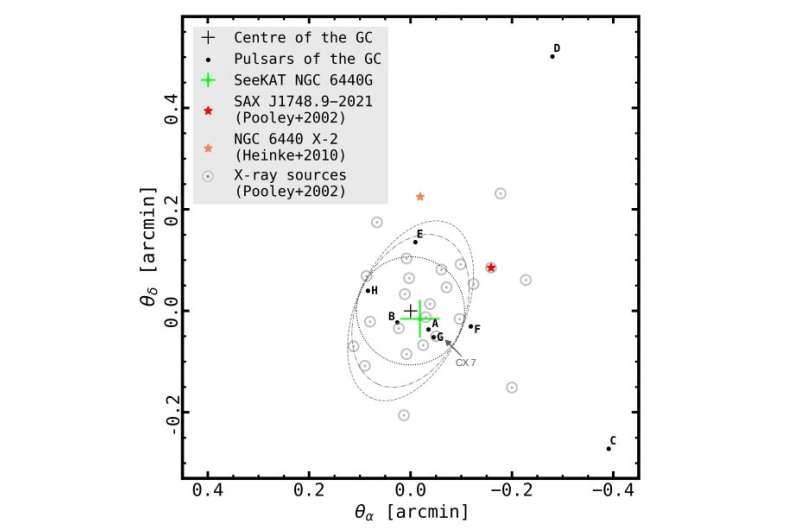April 12, 2022 report
Two millisecond pulsars detected in globular cluster NGC 6440

Using the MeerKAT radio telescope, an international team of astronomers has investigated a globular cluster known as NGC 6440. In result, two new millisecond pulsars have been detected in this cluster, which received designations NGC 6440G and NGC 6440H. The discovery was presented in a paper published April 1 on the arXiv pre-print server.
Pulsars are highly magnetized, rotating neutron stars emitting a beam of electromagnetic radiation. They are usually detected in the form of short bursts of radio emission; however, some of them are also observed via optical, X-ray and gamma-ray telescopes.
The most rapidly rotating pulsars, those with rotation periods below 30 milliseconds, are known as millisecond pulsars (MSPs). Researchers assume that they are formed in binary systems when the initially more massive component turns into a neutron star that is then spun up due to accretion of matter from the secondary star.
A class of extreme binary pulsars with semi-degenerate companion stars is dubbed "spider pulsars." These objects are further categorized as "black widows" if the companion has extremely low mass (less than 0.1 solar masses), and they are called "redbacks" if the secondary star is heavier.
Now, a group of astronomers led by Laila Vleeschower of the University of Manchester, UK, reports the finding of two new MSPs, namely NGC 6440G and NGC 6440H. The two pulsars were detected in NGC 6440—a massive and dense globular cluster (GC) located some 27,000 light years away, in the constellation of Sagittarius. The discovery is a result of 33 observations using the L-band (856-1,712 MHz) receivers of the MeerKAT telescope (with a central frequency of 1,284 MHz).
According to the paper, NGC 6440G (other designation PSR J1748–2021G) is an isolated MSP with a spin period of approximately 5.22 milliseconds. The pulsar has a dispersion measure of about 219.6 pc/cm3.
NGC 6440H (or PSR J1748–2021H) is a binary MSP with a spin period of 2.85 milliseconds. The pulsar has a very low-mass companion (with a minimum mass of around 0.006 solar masses) orbiting the host every 0.36 days, which indicates its "black widow" nature. The dispersion measure of this MSP was estimated to be 222.6 pc/cm3.
The discovery made by Vleeschower's team expands the list of known pulsars in NGC 6440 to eight (four isolated and four binary pulsars). The researchers noted that NGC 6440H has so far the lightest mass companion among any other known pulsars in globular clusters.
"The companion to NGC 6440H is also the lightest mass pulsar companion so far known in a GC, with a minimum mass of 0.006 M. The two new additions maintain the previously observed equal ratio of isolated and binary pulsars in NGC6440 (now 4:4), and contribute to the pulsar discoveries in GCs using MeerKAT," the astronomers concluded.
More information: L. Vleeschower et al, Discoveries and Timing of Pulsars in NGC 6440. arXiv:2204.00086v1 [astro-ph.HE], arxiv.org/abs/2204.00086
© 2022 Science X Network




















